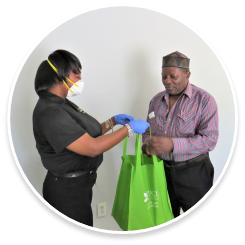Peter Fitzgerald, EVP, Policy and Strategy, National PACE Association
Over 30 years ago, the Program of All-Inclusive Care for the Elderly (PACE) was born out of necessity and began an evolution based on experience. The necessity in 1972 San Francisco was finding an alternative for Chinese American families placing their elders in nursing homes that were far from where they lived, isolating them both physically and culturally. These families knew that with some help, their loved ones could continue living safely at home. In response, On Lok, meaning “peaceful, happy abode” in Cantonese, originated the PACE care model, beginning as an adult day health center. The experience of observing how the totality of a person’s needs determined their ability to maintain their health and quality of life drove the evolution of the program. Over time, services were added to address the holistic needs of the older adults in On Lok’s care, their “participants.”
As of October 2020, 135 PACE organizations across 31 states implement PACE, a comprehensive care model integrating Medicare and Medicaid coverage under a capitated payment structure. PACE organizations holistically address all participants’ health care needs, inclusive of medical care, long-term services and supports, behavioral health and the social determinants of well-being: nutrition, supportive housing, social engagement, transportation, and family support. PACE represents an answer to the question often posed when people get together to talk about a better way of caring for high need, high cost populations: “What if there was a program that fully integrated all care and coverage, uses an interdisciplinary team, and addresses social determinants of health under a capitated payment model aligning financial incentives with quality of care and quality of life?” There is such a program: PACE.
PACE’s Response to the COVID-19 Pandemic
The history of PACE tells us a great deal about how PACE organizations have responded to the COVID-19 public health emergency confronting us today. Adhering to its founding principle of keeping older adults at home, and drawing on the direct care resources at their disposal, PACE organizations redesigned their care model. When the pandemic struck, 95 percent of PACE participants, all of whom meet their state Medicaid agency’s criteria for needing a nursing home level of care, were living in a community setting rather than in a nursing home.
Drawing on the ingenuity behind the evolution of the PACE model and their ability to provide individualized services, PACE organizations were able to maintain this high level of community living for older adults. PACE centers ceased activities that congregated participants to avoid the risks of virus exposure. Care providers, including primary care physicians, nurse practitioners and physician assistants, nurses, therapists, social workers, personal care aides and others, formerly based at PACE centers were deployed into homes. At some PACE organizations, their transportation vans became mobile health clinics. Social workers and outreach staff made daily phone calls to check in on participants and reduce social isolation. Home meals were delivered, virtual activities and events organized, and in-home medical care was provided, often employing newly acquired telehealth technologies. Many of these innovations, and more, were described in a recent Playbook webinar on PACE’s response to the COVID-19 public health emergency.
A family member of a PACE participant described her father’s experience this way:
PACE’s Flexibility to Meet Changing Needs Amid the Pandemic
There is something unique on display in the PACE response to the COVID-19 crisis. Unlike standalone, fee-for-service providers, PACE organizations have the flexibility under their capitated payment to restructure and reorient their services to meet their participants’ needs while minimizing exposure to the virus. PACE organizations could also address their participants’ care needs comprehensively — for example, by having a home care worker who is in a person’s home to assist them with dressing also help them navigate a telehealth visit with the participant’s primary care provider. Unlike capitated insurance plans largely reliant on their contracted provider networks, PACE organizations were able to mobilize their direct care staff — with established participant relationships — to place more services in the home and thereby maintain access to care. This response was critical to the well-being of the medically fragile older adults with functional and/or cognitive impairments who are enrolled in PACE.
These features of the PACE model have made a difference for their participants, all of whom are at a nursing home level of care, and 90 percent of whom are dual-eligible. In spite of these risk factors, PACE participants have experienced a relatively low rate of infection and death due to the COVID-19 virus. Based on data reported to the National PACE Association by 107 PACE organizations, 6.45 percent of PACE participants have had a positive test result for the virus. Of all participants enrolled in these PACE organizations, 1.6 percent have died as a result of the virus. Notably, this is less than half of the 3.4 percent death rate for residents in long-term care facilities (nursing homes and assistant living facilities).
The response of PACE to the COVID-19 pandemic highlights the strengths of a provider-based, comprehensive, fully integrated and capitated care model. Unfortunately, these strengths are not available to the vast majority of people who would benefit from them. PACE organizations serve approximately 54,000 older adults nationally. In comparison to the over 2.2 million Medicare and Medicaid eligible individuals needing long term services and supports, PACE is currently serving less than 2.5 percent. Access is even worse when considering all Medicare-eligible older adults — estimated to be over 12 million — with the same needs.
Opportunities to Expand Access to PACE Programs
Some of the limited access is due to PACE being a bit ahead of its time — 30 years ago, providers were extremely hesitant to assume the financial risk associated with being responsible for providing comprehensive coverage of all Medicare and Medicaid services. Today, however, value-based purchasing, population health management, and financial risk are the hallmarks of innovative health care systems and providers. It is likely, with state and federal policy support and the performance of PACE during the pandemic, that many willing and able providers will step forward to sponsor PACE expansion. If these providers are met by state and federal policymakers willing to address current barriers to PACE, the lives of older adults in communities across the country will be improved. But state and federal policymakers must set the stage for increased access to PACE by adopting policy changes that:
- Give Medicare beneficiaries a choice of affordable Part D plan coverage options to reduce their out of pocket costs when enrolled in PACE;
- Allow PACE enrollment throughout the month so services are available when the older adult needs them, rather than restricting enrollment to one day a month;
- Create Medicaid eligibility systems to expedite access to PACE for individuals in need of post-acute care;
- Expedite PACE organizations’ ability to expand the number of service locations they operate and the geographic areas they serve;
- Allow PACE organizations to be developed and expanded in response to increasing consumer demand, rather than arbitrary budget constraints; and
- Implement PACE pilots to test the model’s ability to serve a wider range of high-need, high-cost populations including people under the age of 55 with physical or intellectual and developmental disabilities, early onset or early stage Alzheimer’s disease, behavioral health needs and end stage renal disease.
As the pandemic continues, expanded access to PACE could save lives. And beyond the pandemic, expanded access to PACE would offer families and communities across the country what it first offered in San Francisco: a peaceful, happy abode in which to maximize quality of life and quality of care.


